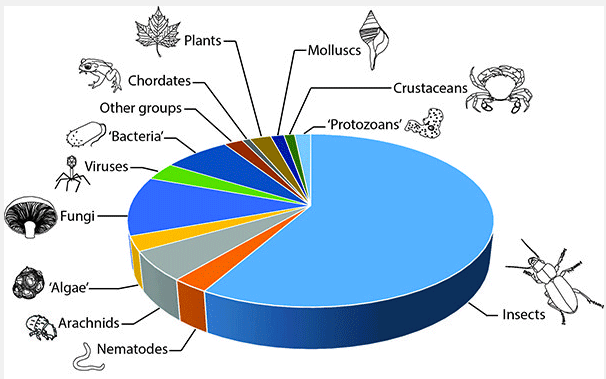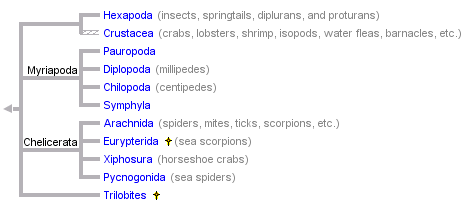Arthropods
To repeat the introduction:
It is impossible to do justice to arthropods in any diversity course, even one just about them.

At least 800,000 species of the about 1 million species of animals described to date are Arthropods
A quote from JBS Haldane, one of the founders of the evolutionary synthesis, illustrates the taxonomic concentration of biodiversity. When asked about what he could divine from nature about the Creator, Haldane replied that he must have had "an inordinate fondness for beetles." We will acknowledge this fondness, not only for beetles but insects in general, who are definitely in sheer numbers, mass and species diversity, the most successful animals on this planet. So we will use insects as the example of the typical arthropod, but focus equal attention to the other members of this group. You can take courses entitled entomology that will focus entirely on insects. This may be the only course that allows the other groups equal time. In deference to the arthropods success and from the Cambrian, we will even when considering non-arthropod groups feature every week or so a non-insect member of the arthropods.
Arthropods are Ecdysozoans, have a cuticular skeleton and hence must molt to grow. The most successful phylum they are considered most closely related is the Nematoda. Like nematodes, they shed their outer covering as they grow, but the arthropod cuticle differs both in structure and function from that of nematodes. They posses hard segmented exoskeletons. The molt has a major impact on arthropod life; by some calculations, an arthropod spends 90% of its life preparing to molt, molting, and recovering from the most recent molt.

One of the interesting true morphological synapomorphies is the complete loss of motile cilia in adult and larvae stages. So this is a large clade unique due to at least one morphological character as well as molecular characters.
_____________________________________________________
Common arthropod systems focusing on crustaceans and insects.
1. Respiration
Most crustaceans use gills to breathe. For example, a crayfish has a gill at the base of each leg. These gills are very delicate and are covered by the crayfish's carapace, or shield. This carapace is aligned backwards from the head, allowing water to run through in a channel over the gills, which provides a continuous source of oxygen that allows the crayfish to breathe. The movement of the legs helps circulate water over these gills. What characteristics according to your book define an arthropod. The crustacean gill is a multi-functional organ, and it is the site of a number of physiological processes, including ion transport, which is the basis for hemolymph osmoregulation; acid-base balance; and ammonia excretion. The gill is also the site by which many toxic metals are taken up by aquatic crustaceans, and thus it plays an important role in the toxicology of these species.


Book lungs are found in many arachnids, such as spiders. Each of these organs is found inside an air-filled cavity and connects with the surroundings through a small opening. Book lungs probably evolved from book gills. Although they have a similar book-like structure, they are found in different locations. Book gills are found externally, while book lungs are found internally. Book gills are still found in horseshoe crabs, which have five pairs of them, the flap in front of them being the genital operculum which lacks gills. Book gills are flap-like appendages that effect gas exchange within water and seem to have their origin as modified legs. These appendages move rhythmically to drive blood in and out of the lamellae and to circulate water over them.

Insects use tracheae. http://evolution.berkeley.edu/evolibrary/article/constraint_14
2. Circulation
Circulations can be open or closed or lacking, with most of the exchange occurring via simple diffusion. You should realize the last few microns of all delivery systems is always done by simple diffusion. Diffusion is very effective but only over short distances.
Distance Ave. Diffusion
|
Time |
| Cell membrane thickness 1 micron |
0.0000001 sec. |
| Size of most bacteria or mitochondria 10 microns |
0.001 sec. |
| Diameter of large eukaryotic cells 250 microns |
10 sec. |
| Radius of giant squid axon 2 millimeters |
1 min. |
| Radius of mature ovarian follicle 2 centimeters |
7 hr. |
Mammals 10 centimeters diameter
|
120 days |
| Half height of humans 1 meter |
32 years |
In a closed system, most of the blood (liquid portion and cells) is found within tubes that eventually connect with the heart. Arteries by definition carry blood away and veins carry blood to the heart. There is some exchange in an closed system of fluid within the more permeable capillaries and adjoining body fluid. Here some fluid leaves the vessels to mingle with the extracellular fluid surrounding tissues. It at the arterial end of the capillaries that this fluid via diffusion delivers to most tissues needed nutrients and oxygen. It then re-enters the capillaries at their venule end carrying wastes and carbon dioxide that diffused from the tissues with it back to lungs and eventually the hearts of most organisms.


What is meant by an open circulatory system varies among groups.
Insects have a simple tube. The fluid is pumped a short distance and then mingles with body fluids. The composite fluid is known as a hemolymph (or haemolymph). Muscle movement and some membranes help direct flow toward sinuses that allow hemolymph to bathe vital organs, The fluid is then via muscle movement massaged back to the heart.

Go to this page from a CALS entomology course to learn more about insect circulatory systems. https://www.cals.ncsu.edu/course/ent425/library/tutorials/internal_anatomy/circulatory.html
In crayfish the open circulatory system are more complex. There are numerous arteries directing flow toward vital organs. In some larger crustaceans, a ventral vein may even be found, but arteries do not connect via capillaries to this vein. So open can simply mean, not closed. You have to become familiar with the animal before you know how complex an open system will be.

Notice the ostia which open to allow blood flow back to the heart. We will learn more about open circulatory systems as we progress through the course. The difference between open and closed systems is often a topic introductory courses just get wrong. Statements such as lower animals do not have closed circulatory systems or that only active large animals have closed systems are frequently made in introductory texts. Note those not so large and active earthworms have closed circulatory systems, and arthropods are not lower animals in any sense. But more about that later.
In our typical arthropod lab, students can see the heart beating in its pericardial sac in transparent shrimp and trace the blood until major vessels end. View the films made by students last year via these links.
Beating heart
Open circulation: Artery ends about 16 sec. Then animal moves and so does vessel below tissue at 24. Look for faint bulging out of vessel before animal moves. Due to the small size of the animal, even slight movement affect circulation.
3. Excretory systems
Terrestrial arthropods, including insects, use tube that are extensions of the digestive system, know as malpighian tubules. https://www.youtube.com/watch?v=5IdSruWQG5k

Aquatic crustaceans can simply excrete diluted ammonia through gills and other permeable membranes. Some have green and/or coxal glands that also act as "kidneys".

4. One of the major differences between most vertebrates and arthropods are the types of eyes found in most insects and crustaceans.
Eyes are present in most arthropods. Not all arthropods have compound eyes. Simple eyes or ocelli are present in arachnids, the tiny crustaceans, and most myriapods. An ocellus is simply a small cup with a light sensitive surface backed by light absorbing pigment. The large crustaceans and insects have compound eyes, although many insects and spiders have simple eyes as well. https://www.youtube.com/watch?v=0XxCrDVqvMQ
The lenses in compound eyes can't change focus, so insects can't see things that are far away. The compound eye is very good at seeing things nearby and detecting motion. Image processing is so much more efficient than in humans. The compound eye offers a much greater flicker fusion rate. This means that an insect can assimilate changes in what it's seeing many times more quickly than we can. A magician's hand-tricks are transparent to insects, because the hand is not faster than the compound eye, and a Hollywood movie would look to an insect like a series of still photographs.
View these films on the overall composition of the compound eye and how insects see the world.
Basic structure of a compound eye. https://www.youtube.com/watch?v=TU6bgQnTi18
How an insect views the world. https://www.youtube.com/watch?v=F0MqmNUz6WI
https://www.youtube.com/watch?v=m5XUdvBO_TE
5. It would take too long to explore the arthropod nervous system in detail, but one important difference needs to be noted as the way muscle fibers are innervated in arthropods run counter to what you have learned about muscle innervation in vertebrates. https://www.youtube.com/watch?v=swBruW7Wc7c
6. Hard exoskeletons and necessary molts
To grow, arthropods must molt because of their hard exoskeletons.
The molt has a major impact on arthropod life; by some calculations, an arthropod spends 90% of its life preparing to molt, molting, and recovering from the most recent molt.
Go through the lesson on exoskeletons. found on the Evo 101 website.
http://evolution.berkeley.edu/evolibrary/article/0_0_0/constraint_03
In lab exercise one, you will continue to look at how hard exoskeletons and the appendages with accessory structures such as spines help in making arthropods the successful group they are. To prepare for lab and better understand how arthropods use appendages visit the following websites.
https://www.shapeoflife.org/video/arthropod-locomotion-engineering
What is a foot? Think you know, watch this film. -----
Also adding besides feet, sexy spines and claws------ http://www.youtube.com/watch?v=Ascql_RoeBU&list=PLYuf0dthDz_Zk7-oniXXMNJ9_oVgWDVyN










